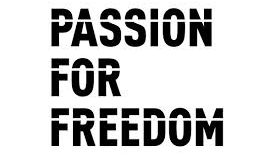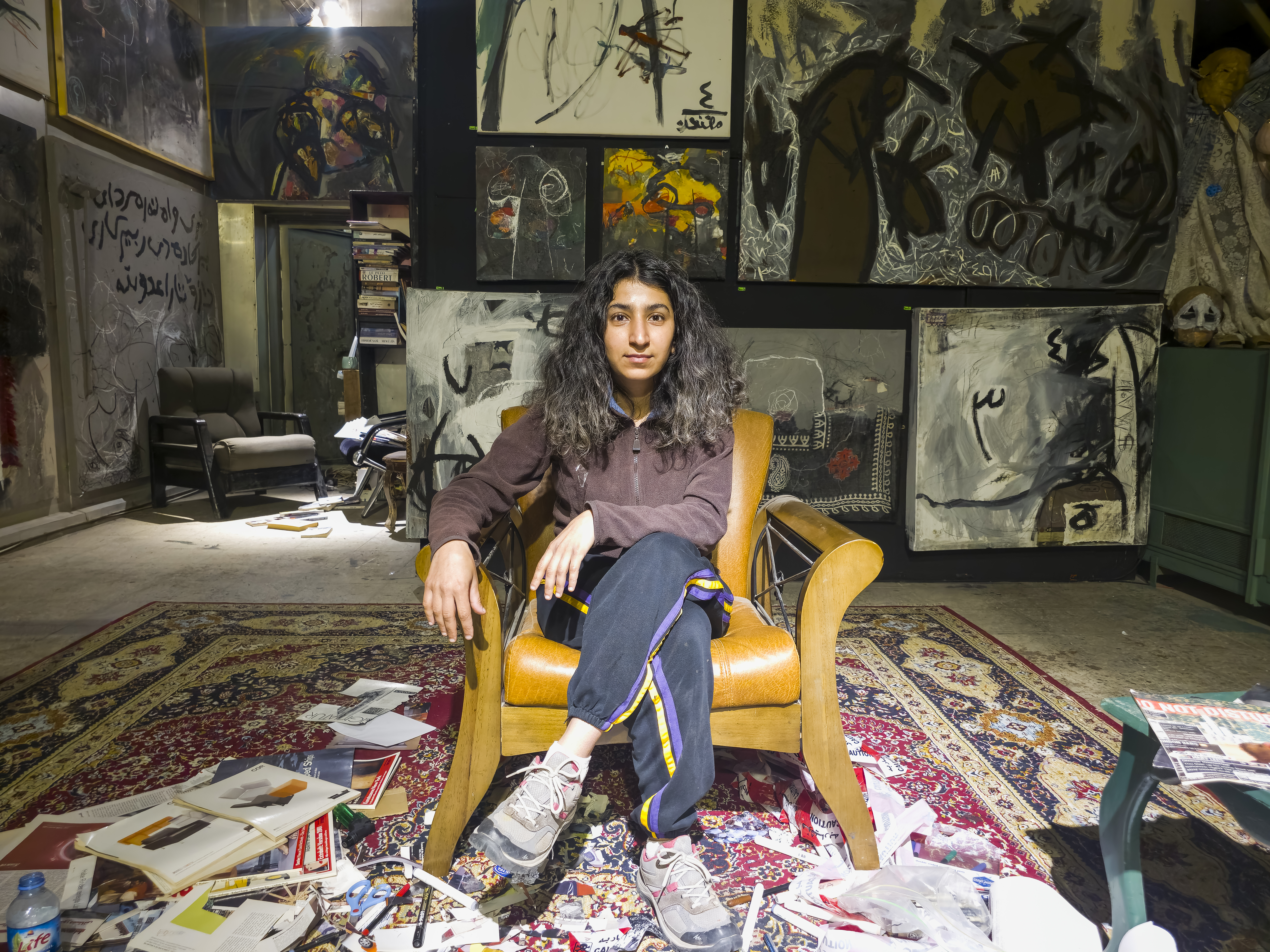A story of a Kurdish Iraqi female artist empowering women through art. Interview with Tara Abdullah
What is freedom? How do we preserve it? And how do we celebrate it?
Freedom is to exist as a human being on this planet, with the ability to exercise your rights and express yourself, whether it’s advocating for women’s rights, environmental protection, or connecting with nature. It’s about having the right to express and experience all of that.
To preserve freedom, especially for me living in Iraq and coming from a region plagued by conflict and war, it’s something that requires constant effort. Every day, every moment, you have to fight for it, work for it, and make continuous efforts towards achieving it, so that you can truly experience it.
The result of the efforts you undertake, the culmination of the struggle for freedom, is the celebration. For me, celebration means experiencing freedom firsthand. Furthermore, this celebration should not be a one-time event, such as a party or commemoration on a single day of the year. Instead, it should serve as a continuous journey, an ongoing continuation. It’s essential not to become stagnant about it, but rather to ensure that the pursuit of freedom persists beyond that moment, avoiding a return to the previous state of affairs.
I also think that freedom is subjective. What may constitute freedom for me and my generation might not necessarily be perceived as freedom by future generations. It’s important to leave space or an opportunity for future generations or other individuals to define and pursue freedom in their own terms, rather than imposing our own concept of freedom onto them.
How did you begin your artistic journey, and what led you to use art as a means to address topics such as freedom, social justice, and particularly violence against women?
Starting from the fact that this entire region is largely dominated by Islam, Islamic ideology, and strict traditions, it’s significant that art is almost forbidden in Islam, and many forms of art are not practised. But even being a woman in this society and region entails facing numerous constraints and suppression, thereby restricting freedom. That’s where it all began. The artistic journey aimed to interrogate these matters: how Islam and traditions restrict art, and also how they impact women.
And this is what I try to reflect in my art. For example, questioning why women can’t wear what they want to wear or why they can’t sing or speak loudly, and so on. All these restrictions that were imposed on women are reflected in my art from the early days of my artistic journey. I had these questions, and I tried to express these concerns through art.
All these concerns were present when I was studying art in the art institute for five years, and later in college for four years studying fine arts. These questions centred around why women felt confined not just externally within the confines of their homes, but also internally, within their own bodies, unable to fully experience life and freedom. These questions were significant for me, and they marked the beginning of my serious exploration of these subjects.
What led you to pursue art? How did you find inspiration to follow this path?
The suppression of art, particularly during my early school years, played a significant role in driving me towards it. In school, there was a lack of emphasis on subjects like art or sports, leaving me with no outlet for expression. Despite this, I felt a strong need to express myself, often resorting to doodling in my maths or other subject notebooks. But even this was met with disapproval from teachers and family who saw my first drawings as defacing the notebooks. This absence of artistic outlets coupled with a growing internal need to express myself fueled my passion for art rather than deterring me from it. It was this sense of longing for expression that ultimately led me into the world of art.
After ninth grade, I enrolled in the College of Fine Arts, which initially caused a lot of friction with my family. They were hesitant to support my decision because art schools are generally disregarded here, and there’s a prevailing discouragement against pursuing such paths. To convince my family, I had to paint a rosy picture, assuring them that I would create valuable art that would sell for a good price, bringing in a substantial income. Of course, that never materialised (she laughs). I had to take on side jobs to make ends meet while studying at the college and art institute. That’s how I spent nine to ten years immersed in fine arts education. So, my journey into art was filled with struggles and obstacles, but facing those challenges ultimately made me stronger.
Throughout my adolescence, what truly motivated me to study art and delve into researching violence against women, was observing the experiences of women close to me, such as my sister and my mother. I could discern that they were almost conditioned to conform to certain behaviours and expectations imposed upon them. It became evident to me that they needed to break free from these moulds and experience true liberation. That’s where the connection between my art and freedom lies. Women are shaped to fit a certain mould without even realising it. You could be twenty years old and not understand why you’re expected to conform to certain gender roles; they simply program you to accept it without question.
One of your earliest art projects that gained international recognition was the Feminine Project, known for its powerful yet innocent portrayal. It involved women’s clothes hanging along the main street of your hometown of Sulaymaniyah. How did the idea for this installation come about?
It all began when I started noticing a peculiar pattern while observing washed clothes hanging on clotheslines to dry in the sun. I observed that women’s clothes, particularly underwear, were consistently hidden beneath men’s garments, positioned in a way that rendered them invisible to the sun. This struck me as a denial of even the basic right for clothes to be exposed to sunlight properly. It felt as though the clothes themselves were deprived of their rights. This observation sparked the idea for the project.
Feeling a sense of shame and embarrassment about this situation, I believed it needed to be addressed and corrected. To initiate the project, I conducted extensive research, including a survey. I visited various neighbourhoods in both the city and surrounding towns, going door to door to speak with women about their experiences. Those who had faced domestic violence were invited to contribute to the project by offering a piece of clothing they remember they wore when they were beaten or assaulted. This was how I collected the clothes, but it wasn’t just about the garments themselves. I also collected the accompanying stories, documenting them in writing. This thorough research laid the foundation for the process of hanging, stitching, and displaying the clothes in the installation.
During the research, there were instances where many women refused to provide their clothes or engage in conversation. This reluctance stemmed from the fear that their identities would be exposed. They perceived the initiative as yet another women’s organisation gathering their information, which could potentially compromise their privacy and safety. At times, I had to offer clarification to alleviate their concerns. Women expressed apprehension about their names being disclosed, fearing potential repercussions. Consequently, many women were hesitant to participate, as some of them also associated the project with rituals, curses, or magic due to cultural and religious indoctrination. The belief that people could use clothing for magical purposes led some women to refuse to contribute their clothes.
Despite these challenges, ninety-nine thousand women ultimately participated in the project.
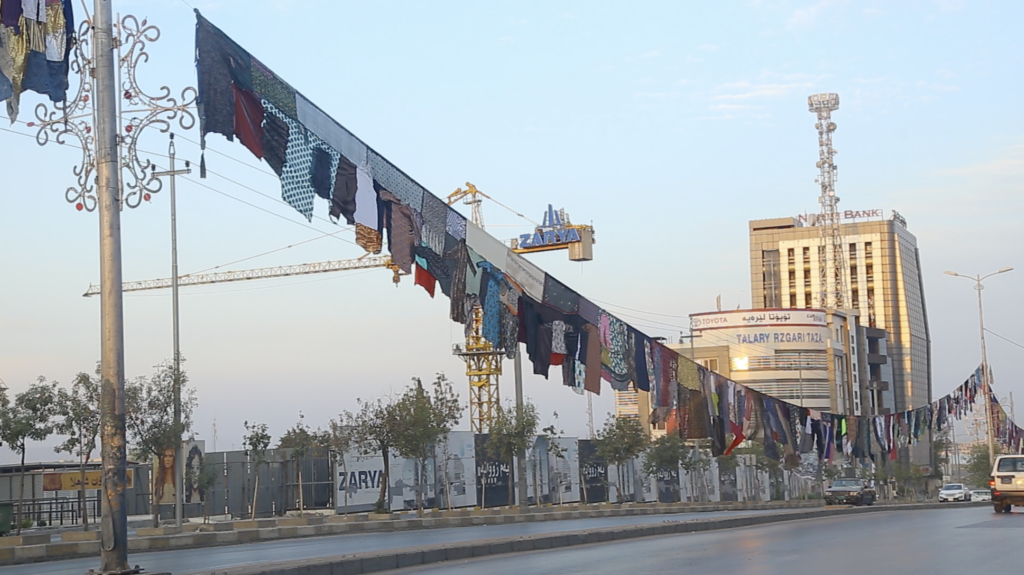
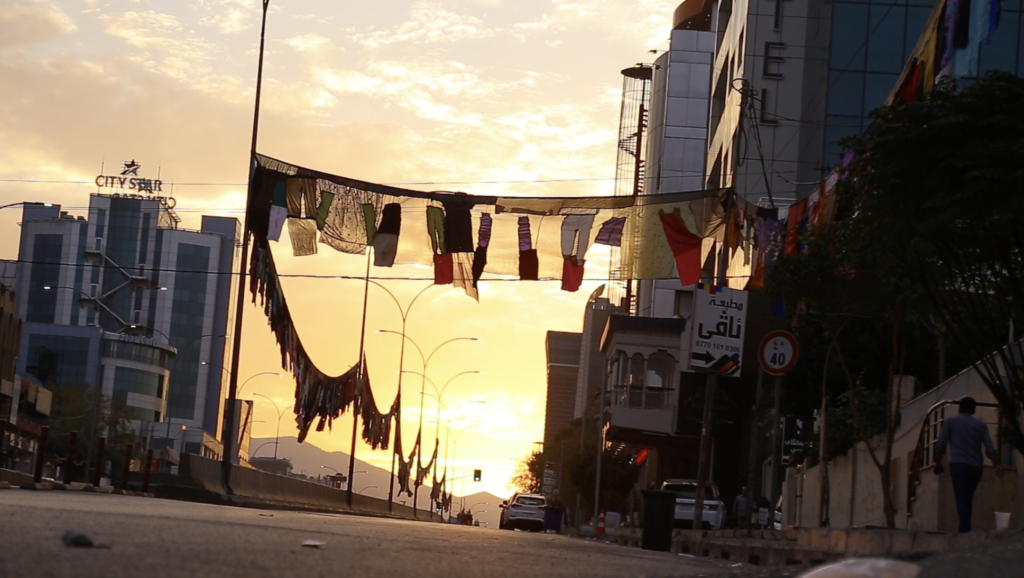
Did you say ninety-nine thousand…?!
Yes, ninety-nine thousand women participated, and the line of clothes stretched over 5 kilometres, with each item representing a woman I interviewed. I stitched all the clothes together, symbolising a unified protest, with each garment standing shoulder to shoulder in a silent plea for ending the violence. For the first day of the public exhibition, I employed a method akin to the shock a woman experiences when facing violence. Just as a woman is often caught off guard and unsure of what’s happening during an incident of violence, I aimed to shock society itself.
We hung the 5-kilometre-long clothesline along the main street of the city overnight, working as a team together with my partner and helpers from the charity organisation. By morning, as people ventured out onto the bustling main street, they were met with a shocking sight: the clothesline stretching as far as the eye could see. This unexpected display provoked a reaction of confusion and disagreement among passersby, mirroring the disorientation experienced by women facing violence.
And this is when you faced condemnation and criticism. I’m interested to know how you handled this feedback.
Clothes were torn down, some even set ablaze on the streets. Threats and curses flooded social media, branding the display as unacceptable. It sparked widespread online discussion, and I began to receive threats myself. Yet, none of this hurt as deeply as the opposition from authorities and those in power. They condemned the project, claiming it tarnished the city’s reputation, especially in the eyes of foreigners. They argued that not all these women could have possibly experienced violence, implying deceit. What hurt me the most was the stark contrast: Sulaymaniyah is notoriously infamous for so-called honour killings, with many nameless graves in dedicated graveyards for women beaten to death by their husbands, neighbours, or families. Their crime? Often simply refusing to conform or unintentionally sparking male anger. How can the city’s image remain untarnished by these tragedies? Instead, it was an art exhibition capturing the raw emotions and experiences of the still-living, silently suffering women that drew condemnation. To me, that was the true injustice.
At the end of the day, I had to dismantle the installation, because it could have led to riots or cause damage as well as potential injuries. The primary reason for taking it down was safety concerns. We did it under the cover of night. At that time I chose not to engage in media interviews or press conferences to discuss the threats or criticise politicians, as I didn’t want the focus to shift from the issue of violence against women. I aimed for the conversation to stay focused on that topic rather than turning into a conflict between the artist and the authorities.
How did the backlash impact you personally? Were you intimidated as both an artist and a woman?
The first thing that happened was that I was beaten by my father. Throughout the time when I was conducting research and surveying the women, which was right after I completed university, I had been telling my family that I was involved with a charity organisation providing assistance to people in need, such as food and other aid. That’s how I managed to convince them to allow me to go out and do the research and work. However, when news about me spread across social media and in the news, my family found out, and their first reaction was that I got beaten up, quite ironically, really (she laughs). You’re asking me if I was scared? After hearing stories of all these women, after facing numerous threats from strangers and after being physically assaulted by my own father, I felt that any fear I may have had had dissipated long ago. I don’t know how to explain this. I no longer harbour any fear towards them or towards my endeavours aimed at advocating for women’s freedom. There is simply no fear within me in this regard.
Do you believe that the women who contributed their pieces of clothing also felt empowered? Have you received any feedback from them?
Yes, indeed. Immediately after the situation escalated and it became a widely discussed topic, I received numerous messages from women expressing their gratitude. They shared that they had long had a desire to defy their oppressors, and participating in this project made them feel like they had achieved that to some extent, leaving them feeling empowered. They expressed solidarity, but many of them couldn’t openly support me due to potential repercussions. On the flip side, I also received negative comments and criticism from some women, particularly those with more extreme Islamic views. They accused me of promoting shamelessness among women and criticised the idea of women allowing themselves to engage in confrontation. But after listening to all those painful, brutal, and true stories nothing could stop me anymore. I knew that my mission was to tell these stories to the world.
And this led to the Sound Project that you conducted in 2022, which, along with the Feminine Project, won the 1st Prize in the Alpine Fellowship Visual Arts Prize last year, an international competition organised by a UK-based foundation.
After completing the Feminine Project, I continued to observe various forms of oppression faced by women. One significant aspect was the restriction on women’s voices: they were expected to speak softly and with a low tone, dictated by societal norms and Islamic teachings that forbid women from speaking loudly. Meanwhile, amidst these constraints, I couldn’t help but notice that while women were silenced, men were permitted to use loudspeakers to amplify their voices. Every day, the call to prayer echoed through hundreds of mosques across the city, with men loudly summoning for prayer. Moreover, men were allowed to use bullhorn speakers for conducting business, such as selling groceries in markets and neighbourhoods. This profound disparity inspired the inception of the Sound Project.
I had gathered numerous stories from women and observed the various restrictions they faced. This led me to conceive the idea of condensing all these narratives, complaints, and messages into a concise two-minute audio message. This message would encapsulate the myriad problems women encounter in society and boldly broadcast it through a network of speakers I installed in four cities in our region: Sulaymaniyah and three others nearby. These speakers, totaling sixty-six in number, were strategically placed throughout these cities. Suddenly, the voice of a woman would reverberate through the streets, boldly declaring, ‘This is me speaking without permission. I am every murdered girl, every immolated girl, every female you have trapped within your walls. Today I come screaming – can you hear my voice?’ and so on. The complaint message essentially conveys a powerful plea to cease the ongoing injustices faced by women. It addresses various entities, including schools, mosques, society, and families, demanding an end to the mistreatment. It’s like turning around and boldly proclaiming, ‘Stop! This is what’s in my heart, and I demand that it be heard.’
Once again, I relied on the element of shock to capture people’s attention, leaving them wondering about the source of this unexpected broadcast. I thought that perhaps during the airing of the voice message, there might be a man on the brink of violence against a woman, or a woman facing imminent assault, suddenly confronted by the unexpected voice. They may grapple with pinpointing the voice’s origin, fostering a sense of unease or mystery, as if it’s emerging from their subconscious or even a divine entity. I aimed for this surprise and uncertainty to profoundly amplify the impact of the project’s message and its reception within society.
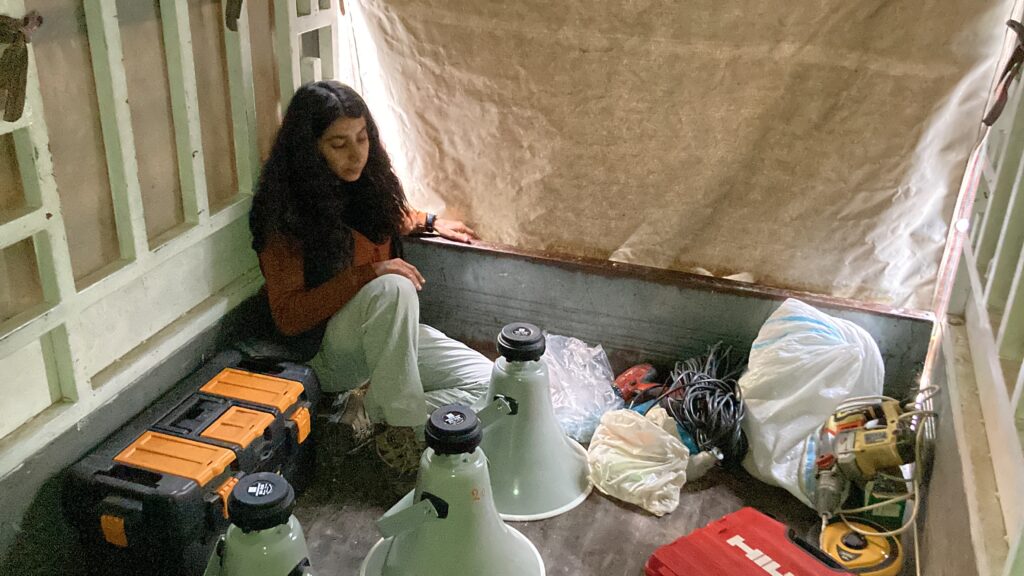
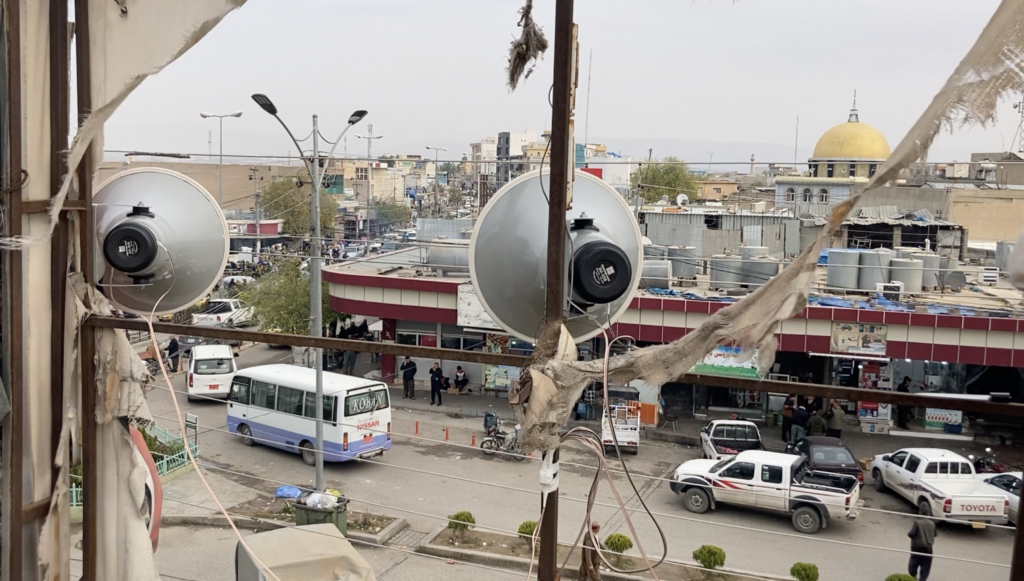
And I am sure you succeded.
Yet again I met with backlash. But first, men on the streets started to take the speakers down, either dismantling them, cutting off their electricity. Clerics and religious leaders, particularly from the Ministry of Religious Affairs, sought to lodge complaints and pursued legal action against me and those who assisted. They filed a court case against me, and the situation became increasingly threatening. The authorities warned me that they couldn’t guarantee my safety, so I had to go into hiding. My husband and I had to flee to Lebanon. We stayed there for 20 days.
After my return, I chose to step back from embarking on major projects like those, as I found myself facing blacklisting from various organisations, governmental bodies, and authorities. Take, for instance, the Feminine Project, which I undertook in collaboration with an organisation. Due to the significant threats they received, they have since distanced themselves from any further collaboration with me. I understand their stance, as they too encountered substantial risks, such as threats to storm their organisation’s buildings and personal threats. Feeling marginalised locally, I began seeking funding and support from international organisations, such as one in Germany, with whom I collaborated on an environmental project involving recycling materials with children. My current objective is to transition into a phase where I can continue my work from outside the country, assisting not just women but also the broader community.
Do you feel that your art has been compromised, leading you to shift away from topics that cause discomfort to Islamists, such as women’s rights, towards more easily accepted topics like environmental protection?
Absolutely not. I would say that such an interpretation is rather oversimplifying. Firstly, I think that the environmental situation mirrors the plight of women facing violence because both issues challenge those in power and societal norms. Even during my early university days, I directed a performance with an environmental organisation to raise awareness. We used plastic figures dressed in protective gear, yet faced backlash for using items like condoms and sanitary pads, as I wanted to indirectly advocate for women’s rights such as sexual health and sexual education rights. People criticised us, saying we should focus on more pressing issues like poverty rather than the environment. Moreover, environmentalists themselves face threats, as seen with activists opposing oil and industrial companies. My husband, a biologist working with environmental organisations, has witnessed locals receiving threats for opposing destructive practices like building refineries in forests. So, being an environmentalist isn’t without risks either. This is also a fight for freedom, our right to a healthy planet.
Ultimately it comes down to this: when a woman undertakes any endeavour, whether it pertains to women’s rights, environmental concerns, or any other cause, it’s generally accepted as long as it remains peaceful and doesn’t stir up any disruptions such as riots or societal upheavals. However, if you try to take it to the next level and reach out to society, to enact change, that’s when it becomes restricted, whether it’s about the environment or women’s issues.
How does international support influence your work?
I was deeply appreciative of the support from an institute in Germany for the environmental project, as well as receiving an award in Switzerland in 2022. Receiving the Visual Arts Prize from the Alpine Fellowship organisation was an immense honour for me. This recognition opened doors, including an invitation to Sweden for a symposium, marking a significant milestone in my career. Engaging with diverse cultures and forging connections with people from various backgrounds enriched my life profoundly and I believe that it will allow me to continue my work as an artist but also that the global recognition ultimately can help raise awareness about women in my community. Currently, I’m thrilled to be shortlisted for the Future Generations Art Prize, hosted by the Pinchuk Art Centre in Ukraine. I eagerly await this opportunity as it promises to broaden my network, inspire new creative endeavours, and contribute to both local and international art communities.
What sort of impact do you want to create with your art projects for your communities and beyond?
My greatest aspiration is for everyone to experience true freedom. It’s disheartening that despite the world rapidly advancing technologically and embracing all-encompassing progress, there are still regions like ours where women face discrimination and violence. Through my art, I aim to shed light on these issues and contribute to the elevation of women’s rights, ultimately fostering freedom for all individuals.
Would you like to tell us about your upcoming projects?
I’m currently involved in a project that I can’t disclose in detail yet. It revolves around women and their experiences, and I’m actively researching and seeking funding for it. I’m excited about the concept and hope to share more details soon once everything is finalised.
Author: Sara Komaiszko
